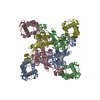[English] 日本語
 Yorodumi
Yorodumi- PDB-7x5v: NaVEh Sodium channel, and NaVEh from the coccolithophore Emiliani... -
+ Open data
Open data
- Basic information
Basic information
| Entry | Database: PDB / ID: 7x5v | |||||||||||||||||||||
|---|---|---|---|---|---|---|---|---|---|---|---|---|---|---|---|---|---|---|---|---|---|---|
| Title | NaVEh Sodium channel, and NaVEh from the coccolithophore Emiliania huxleyi | |||||||||||||||||||||
 Components Components |
| |||||||||||||||||||||
 Keywords Keywords | TRANSPORT PROTEIN / ion channel | |||||||||||||||||||||
| Biological species |  Emiliania huxleyi (eukaryote) Emiliania huxleyi (eukaryote) | |||||||||||||||||||||
| Method | ELECTRON MICROSCOPY / single particle reconstruction / cryo EM / Resolution: 2.83 Å | |||||||||||||||||||||
 Authors Authors | Jiang, D. / Zhang, J. | |||||||||||||||||||||
| Funding support |  China, 1items China, 1items
| |||||||||||||||||||||
 Citation Citation |  Journal: Nat Commun / Year: 2022 Journal: Nat Commun / Year: 2022Title: N-type fast inactivation of a eukaryotic voltage-gated sodium channel. Authors: Jiangtao Zhang / Yiqiang Shi / Junping Fan / Huiwen Chen / Zhanyi Xia / Bo Huang / Juquan Jiang / Jianke Gong / Zhuo Huang / Daohua Jiang /  Abstract: Voltage-gated sodium (Na) channels initiate action potentials. Fast inactivation of Na channels, mediated by an Ile-Phe-Met motif, is crucial for preventing hyperexcitability and regulating firing ...Voltage-gated sodium (Na) channels initiate action potentials. Fast inactivation of Na channels, mediated by an Ile-Phe-Met motif, is crucial for preventing hyperexcitability and regulating firing frequency. Here we present cryo-electron microscopy structure of NaEh from the coccolithophore Emiliania huxleyi, which reveals an unexpected molecular gating mechanism for Na channel fast inactivation independent of the Ile-Phe-Met motif. An N-terminal helix of NaEh plugs into the open activation gate and blocks it. The binding pose of the helix is stabilized by multiple electrostatic interactions. Deletion of the helix or mutations blocking the electrostatic interactions completely abolished the fast inactivation. These strong interactions enable rapid inactivation, but also delay recovery from fast inactivation, which is ~160-fold slower than human Na channels. Together, our results provide mechanistic insights into fast inactivation of NaEh that fundamentally differs from the conventional local allosteric inhibition, revealing both surprising structural diversity and functional conservation of ion channel inactivation. | |||||||||||||||||||||
| History |
|
- Structure visualization
Structure visualization
| Structure viewer | Molecule:  Molmil Molmil Jmol/JSmol Jmol/JSmol |
|---|
- Downloads & links
Downloads & links
- Download
Download
| PDBx/mmCIF format |  7x5v.cif.gz 7x5v.cif.gz | 239 KB | Display |  PDBx/mmCIF format PDBx/mmCIF format |
|---|---|---|---|---|
| PDB format |  pdb7x5v.ent.gz pdb7x5v.ent.gz | 180.1 KB | Display |  PDB format PDB format |
| PDBx/mmJSON format |  7x5v.json.gz 7x5v.json.gz | Tree view |  PDBx/mmJSON format PDBx/mmJSON format | |
| Others |  Other downloads Other downloads |
-Validation report
| Summary document |  7x5v_validation.pdf.gz 7x5v_validation.pdf.gz | 904.7 KB | Display |  wwPDB validaton report wwPDB validaton report |
|---|---|---|---|---|
| Full document |  7x5v_full_validation.pdf.gz 7x5v_full_validation.pdf.gz | 935.6 KB | Display | |
| Data in XML |  7x5v_validation.xml.gz 7x5v_validation.xml.gz | 39.3 KB | Display | |
| Data in CIF |  7x5v_validation.cif.gz 7x5v_validation.cif.gz | 56 KB | Display | |
| Arichive directory |  https://data.pdbj.org/pub/pdb/validation_reports/x5/7x5v https://data.pdbj.org/pub/pdb/validation_reports/x5/7x5v ftp://data.pdbj.org/pub/pdb/validation_reports/x5/7x5v ftp://data.pdbj.org/pub/pdb/validation_reports/x5/7x5v | HTTPS FTP |
-Related structure data
- Links
Links
- Assembly
Assembly
| Deposited unit | 
|
|---|---|
| 1 |
|
- Components
Components
| #1: Protein | Mass: 91684.469 Da / Num. of mol.: 4 Source method: isolated from a genetically manipulated source Source: (gene. exp.)  Emiliania huxleyi (eukaryote) / Production host: Emiliania huxleyi (eukaryote) / Production host:  Homo sapiens (human) Homo sapiens (human)#2: Protein/peptide | | Mass: 1913.298 Da / Num. of mol.: 1 Source method: isolated from a genetically manipulated source Details: N-terminal helix of either of the four protomers / Source: (gene. exp.)  Emiliania huxleyi (eukaryote) / Production host: Emiliania huxleyi (eukaryote) / Production host:  Homo sapiens (human) Homo sapiens (human)Has protein modification | N | |
|---|
-Experimental details
-Experiment
| Experiment | Method: ELECTRON MICROSCOPY |
|---|---|
| EM experiment | Aggregation state: PARTICLE / 3D reconstruction method: single particle reconstruction |
- Sample preparation
Sample preparation
| Component | Name: ion channel complex / Type: COMPLEX / Entity ID: #1 / Source: RECOMBINANT |
|---|---|
| Source (natural) | Organism:  Emiliania huxleyi (eukaryote) Emiliania huxleyi (eukaryote) |
| Source (recombinant) | Organism:  Homo sapiens (human) Homo sapiens (human) |
| Buffer solution | pH: 7.5 |
| Specimen | Embedding applied: NO / Shadowing applied: NO / Staining applied: NO / Vitrification applied: YES |
| Vitrification | Cryogen name: ETHANE |
- Electron microscopy imaging
Electron microscopy imaging
| Experimental equipment |  Model: Titan Krios / Image courtesy: FEI Company |
|---|---|
| Microscopy | Model: FEI TITAN KRIOS |
| Electron gun | Electron source:  FIELD EMISSION GUN / Accelerating voltage: 300 kV / Illumination mode: FLOOD BEAM FIELD EMISSION GUN / Accelerating voltage: 300 kV / Illumination mode: FLOOD BEAM |
| Electron lens | Mode: BRIGHT FIELD / Nominal defocus max: 2500 nm / Nominal defocus min: 1200 nm |
| Image recording | Electron dose: 60 e/Å2 / Film or detector model: GATAN K2 SUMMIT (4k x 4k) |
- Processing
Processing
| Software | Name: PHENIX / Version: 1.17.1_3660: / Classification: refinement | ||||||||||||||||||||||||
|---|---|---|---|---|---|---|---|---|---|---|---|---|---|---|---|---|---|---|---|---|---|---|---|---|---|
| EM software | Name: PHENIX / Category: model refinement | ||||||||||||||||||||||||
| CTF correction | Type: PHASE FLIPPING AND AMPLITUDE CORRECTION | ||||||||||||||||||||||||
| 3D reconstruction | Resolution: 2.83 Å / Resolution method: FSC 0.143 CUT-OFF / Num. of particles: 61065 / Symmetry type: POINT | ||||||||||||||||||||||||
| Refine LS restraints |
|
 Movie
Movie Controller
Controller



 PDBj
PDBj